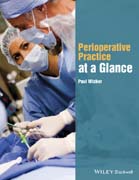
From the publishers of the market–leading at aGlance series comes this new title on all aspects ofcaring for patients in the perioperative environment. Frompre–operative care, through the anaesthetic and surgical phases topost–operation and recovery, this easy–to–read, quick–referenceresource uses the unique at a Glance format toquickly convey need–to–know information in both images and text,allowing vital knowledge to be revised promptly andefficiently. Brings together all aspects of perioperative practice in oneeasy–to–read book Moves through the patient journey, providing support toperioperative practitioners in all aspects of their role Covers key information on perioperative emergencies Includes material on advanced skills to support AdvancedPractitioners Each topic is covered in two pages, allowing for easy revisionand reference This is a must–have resource for operating departmentpractitioners and students, theatre nurses and nursing students,and trainee surgeons and anaesthetists. INDICE: Acknowledgments.Surgical and anaesthetic abbreviations and acronyms.How to use your textbook.Part 1 Introduction to Perioperative Practice.1 Preoperative preparation.2 Theatre scrubs and personal protective equipment (PPE).3 Preventing the transmission of infection.4 Preparing and managing equipment.5 Perioperative patient care.6 Surgical Safety Checklist (Part 1).7 Surgical Safety Checklist (Part 2).8 Legal and professional accountability.9 Interprofessional team working.Part 2 Anaesthesia.10 Preparing anaesthetic equipment.11 Checking the anaesthetic machine.12 Anatomy and physiology of the respiratory and cardiovascularsystems.13 Anaesthetic drugs.14 Perioperative fluid management.15 Monitoring the patient.16 General anaesthesia.17 Local anaesthesia.18 Regional anaesthesia.Part 3 Surgery.19 Roles of the circulating and scrub team.20 Basic surgical instruments.21 Surgical scrubbing.22 Surgical positioning.23 Maintaining the sterile field.24 Sterilisation and disinfection.25 Swab and instrument counts.26 Working with electrosurgery.27 Tourniquet management.28 Wounds and dressings.Part 4 Recovery.29 Introducing the recovery room.30 Patient handover.31 Postoperative patient care Part 1.32 Postoperative patient care Part 2.33 Monitoring in recovery.34 Maintaining the airway.35 Common postoperative problems.36 Managing postoperative pain.37 Managing PONV.Part 5 Perioperative Emergencies.38 Caring for the critically ill.39 Managing airway problems.40 Rapid sequence intubation.41 Bleeding problems.42 Malignant hyperthermia.43 Cardiovascular problems.44 Electrosurgical burns.45 Venous thromboembolism.46 Latex allergy.Part 6 Advanced Surgical Practice.47 Assisting the surgeon.48 Shaving, marking, prepping and draping.49 Retraction of tissues.50 Suture techniques and materials.51 Haemostatic techniques.52 Laparoscopic surgery.53 Orthopaedic surgery.54 Cardiac surgery.55 Things to do after surgery!.References and further reading
- ISBN: 978-1-118-84215-7
- Editorial: Wiley–Blackwell
- Encuadernacion: Rústica
- Páginas: 160
- Fecha Publicación: 24/04/2015
- Nº Volúmenes: 1
- Idioma: Inglés
